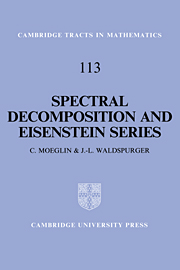Book contents
- Front Matter
- Contents
- Preamble
- Notation
- I Hypotheses, automorphic forms, constant terms
- I.1. Hypotheses and general notation
- I.2. Automorphic forms: growth, constant terms
- I.3 Cuspidal components
- I.4. Upper bounds as functions of the constant term
- II Decomposition according to cuspidal data
- III Hilbertian operators and automorphic forms
- IV Continuation of Eisenstein series
- V Construction of the discrete spectrum via residues
- Appendix I Lifting of unipotent subgroups into a central extension
- Appendix II Automorphic forms and Eisenstein series over a function field
- Appendix III On the discrete spectrum of G2
- Appendix IV Non-connected groups
- Bibliography
- Index
I.2. - Automorphic forms: growth, constant terms
from I - Hypotheses, automorphic forms, constant terms
Published online by Cambridge University Press: 22 September 2009
- Front Matter
- Contents
- Preamble
- Notation
- I Hypotheses, automorphic forms, constant terms
- I.1. Hypotheses and general notation
- I.2. Automorphic forms: growth, constant terms
- I.3 Cuspidal components
- I.4. Upper bounds as functions of the constant term
- II Decomposition according to cuspidal data
- III Hilbertian operators and automorphic forms
- IV Continuation of Eisenstein series
- V Construction of the discrete spectrum via residues
- Appendix I Lifting of unipotent subgroups into a central extension
- Appendix II Automorphic forms and Eisenstein series over a function field
- Appendix III On the discrete spectrum of G2
- Appendix IV Non-connected groups
- Bibliography
- Index
Summary
Siegel domains
Fix an isomorphism T0→ defined over k, where is the multiplicative group. If k is a number field, embed ℝ*+ in, identifying t ∈ with the element (tv) ∈ such that tv = t if v is archimedean, tv = 1 if v is finite. Then is identified with a subgroup of which is split in the extension T0 since is simply connected. We denote by AM0 the unique connected subgroup of T0 which projects onto. If k is a function field, fix once and for all a place V0 of k and a uniformising parameter ∞ at v0. The group generated by ∞ can be identified with a subgroup of and with a subgroup of. By the fact that is contained in ZM0 (see 1.1.3 (2)), we see that there exists a subgroup of ZM0 such that the projection pr : G → G() establishes an isomorphism between this group and a subgroup of finite index of. Fix such a subgroup once and for all, and denote it by AM0- Up to replacing it by
which satisfies the same conditions, we can suppose that AM0 is invariant under the action of W.
More generally, if P = MU is a standard parabolic subgroup of G, we set. Let logM be the composition of the map log : with the projection.
Information
- Type
- Chapter
- Information
- Spectral Decomposition and Eisenstein SeriesA Paraphrase of the Scriptures, pp. 18 - 40Publisher: Cambridge University PressPrint publication year: 1995
